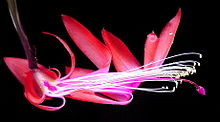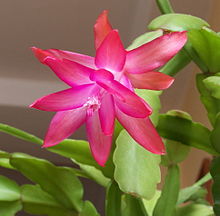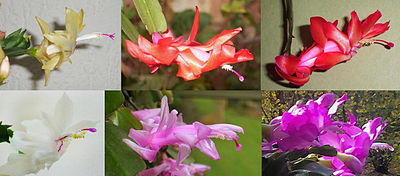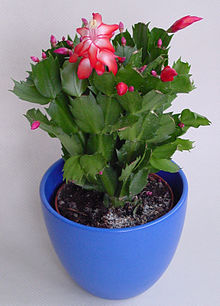- Schlumbergera
-
This article is about the genus Schlumbergera, including the house plants commonly called Christmas Cactus or Thanksgiving Cactus. For the Easter Cactus or Whitsun Cactus, see Hatiora.
Schlumbergera 
Cultivar belonging to the Schlumbergera Truncata Group Scientific classification Kingdom: Plantae (unranked): Angiosperms (unranked): Eudicots (unranked): Core eudicots Order: Caryophyllales Family: Cactaceae Subfamily: Cactoideae Tribe: Rhipsalideae Genus: Schlumbergera
Lem.Species See text
Schlumbergera is a genus of cactus from the coastal mountains of south-eastern Brazil. They grow on trees or rocks in habitats which are generally shady with high humidity and can be quite different in appearance from their desert-dwelling cousins. Most species of Schlumbergera have stems which resemble leaf-like pads joined one to the other and flowers which appear from areoles at the joints and tips of the stems. Two species have cylindrical stems more similar to other cacti. In Brazil, the genus is referred to as Flor de Maio (May flower), reflecting the period in which they flower in the Southern Hemisphere.
This genus contains the popular house plants known by a variety of names including Christmas Cactus, Thanksgiving Cactus, Crab Cactus and Holiday Cactus, which are Schlumbergera cultivars, and flower in white, pink, yellow, orange, red or purple. (The Easter cactus or Whitsun cactus, which may also be called a holiday cactus and has vivid scarlet flowers in the most commonly grown form, is now placed in the genus Hatiora.) The cultivars of Schlumbergera fall into two main groups:
- The Truncata Group contains all cultivars with features derived mainly from the species S. truncata: stem segments with pointed teeth; flowers held more or less horizontally, usually above the horizontal, whose upper side is differently shaped from the lower side (zygomorphic); and pollen which is yellow. They generally flower earlier than members of the Buckleyi Group and although common names are not applied consistently may be distinguished as Thanksgiving Cactus, Crab Cactus or Claw Cactus.
- The Buckleyi Group contains all cultivars with features clearly showing inheritance from S. russelliana: stem segments with rounded, more symmetical teeth; more or less symmetrical (regular) flowers which hang down, below the horizontal; and pollen which is pink. They generally flower later than members of the Truncata Group and are more likely to be called Christmas Cactus.
Contents
Description
In the wild, the species of Schlumbergera grow either on trees (epiphytic) or on rocks (epilithic) and can form sizeable shrubs with woody bases. They are leafless, the green stems acting as photosynthetic organs. The stems are composed of segments, which take one of two forms. In most species the segments are strongly flattened (cladodes) being made up of a central core with two (or more rarely three) "wings". Special structures characteristic of cacti, called "areoles", then occur at the ends of the segments of the stem. In two species the stems are less flattened, more cylinder-shaped, and the areoles are arranged in a more or less spiral pattern all over the segments. In both cases, the areoles, which may have wool and bristles, are where the flower buds appear.[1]
The flowers either hang downwards and are almost regular (radially symmetrical or actinomorphic) or, as in most species, are held more or less horizontally with the higher side of the flower different from the lower side (radially asymmetrical or zygomorphic). In those species whose flowers are held up, their angle with the horizontal is relatively constant and is characteristic of the species. Each flower has 20-30 tepals. The outer tepals – those closer to the base of the flower – are short and unconnected, and spread out or curve backwards. The inner tepals – those towards the tip of the flower – are longer and become progressively more fused together at the base to form a floral tube. In some species the difference between the outer and inner tepals creates the appearance of a "flower within a flower". The flowers produce nectar in a chamber at the base of the floral tube.[1]
The many stamens are arranged in two series, which is a distinctive characteristic of the genus. The inner stamens are fused at the base to form a short tubular structure. The outer stamens arise from along the floral tube. The style is usually dark red and has a stigma with 6–8 lobes; the style plus stigma is roughly the same length as the stamens. If the flower is fertilized, a fleshy fruit forms, either smooth or with ribs. The brown or black seeds are about 1 mm in diameter.[1]
Taxonomy
 Drawing of S. russelliana, the type species, from the Botanical Magazine, 1839
Drawing of S. russelliana, the type species, from the Botanical Magazine, 1839
The taxonomic history of the genus is complicated; it has been detailed by McMillan and Horobin. The modern genus Schlumbergera was created by Charles Lemaire in 1858. The name commemorates Frédéric Schlumberger, who had a collection of cacti at his chateau near Rouen. Lemaire placed only one species in his new genus – a plant discovered in Brazil in 1837 which had been named Epiphyllum russellianum by W.J. Hooker. Lemaire re-named it Schlumbergera epiphylloides (under the rules of botanical nomenclature it should have been called Schlumbergera russelliana, which is its current name).[2]
Lemaire noted the similarity of his Schlumbergera epiphylloides to a species first described as Epiphyllum truncatum by Haworth in 1819, but did not accept that the two species should be included in the same genus. In 1890, Schumann transferred Epiphyllum truncatum to Zygocactus truncatus. Although he later placed it back in Epiphyllum, abandoning Zygocactus, the generic name Zygocactus continued to be widely used.[2]
In 1953, Moran placed both Schlumbergera russelliana and Zygocactus truncatus in the genus Schlumbergera. Other species were added later by David Hunt, including those formerly placed in Epiphyllanthus, to form the modern total of six full species and a number of hybrids.[2]
Synonymy
The following genera are now synonyms of Schlumbergera (i.e. they have no species not moved into Schlumbergera):[3]
- Epiphyllanthus A.Berger
- Opuntiopsis Knebel (nom. inval.)
- Zygocactus K.Schum.
- Zygocereus Frič & Kreuz. (orth. var.)
- Epiphyllum Pfeiff. but not Epiphyllum Haw.
The case of Epiphyllum is complex. Linnaeus had created the genus Cactus. As more species were discovered this proved too broad, and new genera were created to subdivide the cacti. The genus Epiphyllum was created in 1812 by Haworth, based on Linnaeus's Cactus phyllanthus. In 1831 Link created the genus Phyllocactus based on the same species. Following Pfeiffer in 1837, the European tradition was to use Phyllocactus for epiphytic cacti with larger regular flowers and Epiphyllum for the irregular-flowered species now called Schlumbergera truncata. Under modern rules, Phyllocactus is an illegitimate name, as is Epiphyllum in the sense of Pfeiffer; thus Epiphyllum Pfeiff. is a synonym of Schlumbergera.[4] The true genus Epiphyllum Haw. now has around 19 species.[5]
Species
Six species are currently recognized.[6] Only selected synonyms are given in the list below.
- Schlumbergera kautskyi (Horobin & McMillan) N.P.Taylor
- syn. S. truncata subsp. kautskyi Horobin & McMillan
- Schlumbergera microsphaerica (K.Schum.) Hoevel
- syn. Cereus microsphaerica K.Schum., Epiphyllanthus microsphaericus (K.Schum.) Britton & Rose, Cereus obtusangulus K.Schum., Epiphyllanthus obtusangulus (K.Schum.) A.Berger, Zygocactus obtusangulus (K.Schum.) Loefgr., S. obtusangula (K.Schum.) D.R.Hunt
- Schlumbergera opuntioides (Loefgr. & Dusén) D.R.Hunt
- syn. Epiphyllum opuntioides Loefgr. & Dusén, Zygocactus opuntioides (Loefgr. & Dusén) Loefgr., Epiphyllanthus opuntioides (Loefgr. & Dusén) Moran
- Schlumbergera orssichiana Barthlott & McMillan
- Schlumbergera russelliana (Hook.) Britton & Rose
- syn. Epiphyllum russellianum Hook., S. epiphylloides Lemaire, nom. illeg.
- Schlumbergera truncata (Haw.) Moran
- syn. Epiphyllum truncatum Haw., Zygocactus truncatus (Haw.) K.Schum., nom. illeg.
 Cultivar of the S. Buckleyi Group on a Hungarian stamp (not S. truncata)
Cultivar of the S. Buckleyi Group on a Hungarian stamp (not S. truncata)
Four hybrids have been named, all made in cultivation (although the first may possibly occur in the wild).[6][7] The International Code of Nomenclature for Cultivated Plants recommends that cultivated plants should be named under its rules, not those appropriate for natural species and hybrids.[8] The Group names given below were provided by McMillan and Horobin.[9]
- Schlumbergera × buckleyi (T.Moore) Tjaden = S. russelliana × S. truncata; S. Buckleyi Group
- syn. Epiphyllum buckleyi T.Moore, E. rollissonii T.Moore, S. bridgesii (Lemaire) Loefgr.
- Schlumbergera × eprica Süpplie = S. orssichiana × S. russelliana [7]
- Schlumbergera × exotica Barthlott & Rauh = S. truncata × S. opuntioides; S. Exotica Group
- Schlumbergera × reginae McMillan = S. truncata × S. orssichiana; S. Reginae Group
Distribution, habitat and ecology
 The distribution of Schlumbergera species is discontinuous within the red area.[10]
The distribution of Schlumbergera species is discontinuous within the red area.[10]
Schlumbergera occurs only in the coastal mountains of south-east Brazil, in the states of São Paulo, Rio de Janeiro, Minas Gerais and Espírito Santo. Sites where it has been found range from close to the Tropic of Capricorn northwards to 20°S, i.e. in the southernmost part of the tropics.[1] Plants grow at altitudes from 700 metres (2,300 ft) in the case of S. truncata to 2,780 metres (9,120 ft) in the case of S. microsphaerica,[11] in either the coastal moist forests or rocky areas. The natural distribution of Schlumbergera species has become confused because European cultivars were deliberately introduced into some areas, including the Parque Nacional da Serra dos Órgãos, by the Brazilian Agricultural Department, to compensate for over-collecting of wild plants.[12]
Because of their height and proximity to the Atlantic Ocean, the coastal mountains produce high altitude moist forests – warm moist air is forced upwards into higher, colder locations where it condenses. Schlumbergera species grow in habitats which are generally relatively cool, shaded and of high humidity. David Hunt describes collecting specimens in conditions of cloud, drizzle and overnight temperatures down to −4 °C (25 °F).[13] Plants are epiphytic or lithophytic, growing on moss-covered tree branches or in rock crevices, often in small pockets of substrate formed from decayed leaves and other vegetation.[14] S. microsphaerica is found at higher altitudes, above 2,200 metres (7,200 ft),[11] in barren rocky habitats,[13] and tolerates higher light levels.[15]
The flowers of Schlumbergera have adaptations for pollination by humming birds: tubular flowers with abundant nectar, and colours towards the red end of the spectrum. Most species require cross-pollination to set seed. The exceptions are S. kautskyi and S. microsphaerica; as noted above, the latter is found at higher altitudes where humming birds may be absent or less common.[16]
The fruits of Schlumbergera do not open spontaneously when ripe, and appear to be adapted for distribution by birds, which eat the seeds and pulp contained in the fruit. Birds have been observed removing seeds which had stuck to their beaks by rubbing them on tree branches, where the seeds might be able to germinate. Segments may also break off from the stems, and so propagate plants vegetatively.[16]
Cultivation
History
Schlumbergera truncata was in cultivation in Europe by 1818. S. russelliana was introduced in 1839. Hybrids between the two, now called S. × buckleyi, were made in England by W. Buckley and first reported in 1852. By the 1860s a substantial number of cultivars (cultivated varieties) were available in a range of colours and habits, and were used as ornamental plants in "stoves" (heated greenhouses) and in houses, where they were popular for their autumn and winter flowering. Many cultivars were selected seedlings of S. truncata, but at least three S. × buckleyi hybrids were available. One of these, now called S. 'Buckleyi', is thought to be the plant most widely grown since as the common Christmas Cactus. By the early part of the 20th century, the genus had become less popular, and many of the early cultivars were lost.[17]
From around the 1950s onwards, breeding resumed in Europe, North America, Australia and New Zealand. New plants were produced by crossing among the species and existing cultivars of S. truncata, S. russelliana and the hybrid S. × buckleyi. Treatments which induced mutations were also used. The result was a wide range of flower colours which had not been available before, including the first true yellow to be sold commercially, S. 'Gold Charm' (which was a sterile triploid). Breeders aimed for plants which grew strongly, were upright at the point of sale rather than pendulous, had many flowers or buds, and were adapted to living as house plants.[17]
In the 1980s the species S. orssichiana was also used in crosses. The hybrid of S. truncata and S. orssichiana has been named S. × reginae or S. Reginae Group; one of the first cultivars was S. 'Bristol Queen'. S. opuntioides crosses have also been made, but have not resulted in commercially available cultivars.[17]
Modern cultivars
McMillan and Horobin have listed hundreds of modern European, North American and Australian cultivars, which they put into a number of cultivar groups:[18]
- The Truncata Group contains all cultivars with mainly S. truncata characteristics: stem segments with pointed teeth (dentate); zygomorphic flowers held more or less horizontally, usually above the horizontal; and pollen which is yellow.
- The Buckleyi Group contains all cultivars with features clearly showing inheritance from S. russelliana: stem segments with rounded, more symmetical teeth (crenate); more regular flowers which hang down, below the horizontal; and pollen which is pink. There is considerable variation within this Group; McMillan and Horobin introduced subcategories: "TB" for those more like S. truncata and "BT" for those more like the classic S. × buckleyi, with "B" reserved for the first generation (F1) S. × buckleyi hybrids.
- The Reginae Group contains cultivars known to be derived from hybrids with S. orssichiana.
- The Exotica Group is used for the small number of hybrids involving S. opuntioides.
Attempts have also been made to classify cultivars by colour. A difficulty is that the flowers of many cultivars exhibit different colours depending on the temperature during bud formation and growth. In particular, temperatures below 14 °C (57 °F) produce pink tones in otherwise white and yellow cultivars, and strengthen the colour in pink and red cultivars. The availability of iron to the plant has also been suggested to affect flower colour.[18]
In the United States, cultivars are propagated in large numbers for sale before Thanksgiving Day (the fourth Thursday in November). In Europe, plants are mainly sold later in the year, in the period before Christmas. A single Dutch grower was reported in 1989 as producing 2,000,000 plants per year.[18]
Common names
Plants are offered for sale under a variety of common names. The earliest English common name was "Christmas Cactus". In Europe, where plants are largely produced for sale in the period before Christmas, this remains the most widely used common name in many languages for cultivars of all groups (e.g. Weihnachtskaktus in German,[19] Cactus de Noël in French,[20] and Cacto de Navidad in Spanish[21]). This is also the name used in Canada.[22] In the United States, where plants are produced for the Thanksgiving holiday in November, the name "Thanksgiving Cactus" is used; "Christmas Cactus" may then be restricted to cultivars of the Buckleyi Group,[23] particularly the very old cultivars such as 'Buckleyi'.[22] The name "Crab Cactus" (referring to the clawed ends of the stems) is also used for the Truncata Group.[24] "Link Cactus" is another common name, describing the way that the stems of the genus as a whole are made up of linked segments.[22]
The Easter Cactus or Whitsun Cactus is now placed in the genus Hatiora, but was at one time included in Schlumbergera (or one of its synonyms). The name "Holiday Cactus" has been used to include both Schlumbergera and Hatiora cultivars.[22]
Care of cultivars
When grown as house plants, Schlumbergera cultivars are relatively easy to care for. Recommendations for care include:[25]
- Growing medium Free-draining, humus-rich, somewhat acid growing media should be used, such as a mixture of peat or leafmould and an inert material such as grit, sharp sand or polystyrene beads. Plants should be grown in relatively small pots; half-height pots are suitable.
- Watering They are more tolerant of drought than many house plants, but can be damaged by both under- and over-watering. The growing medium should be kept just moist throughout the year.
- Light They should not be exposed to more than intermittent sunlight. Members of the Buckleyi Group, such as the old-fashioned Christmas Cactus with pendant flowers, are more tolerant of high light levels than members of the Truncata Group, such as most of the modern cultivars. Too much light causes stems to take on a reddish colouration; however, very low light levels will prevent flowering. Day length is important; continuous darkness for at least 12 hours is necessary to induce bud formation. About 8 days with 16 hours of darkness at 16 °C (61 °F) have been shown to cause flower buds to form. Lower temperatures slow this process. The advice sometimes given to withhold water to produce flower buds has been shown to be incorrect.
- Propagation Both commercially and in the home, propagation can be achieved by using short pieces of stem, one to three segments long, twisted off rather than cut. Cuttings should be allowed to dry, forming a callus at the broken end, for 1–7 days and then rooted in an open growing medium. Temperatures above 21 °C (70 °F) and up to 27 °C (81 °F) in long day/short night conditions speed rooting.
References
- ^ a b c d McMillan & Horobin 1995, particularly pp. 18–19
- ^ a b c McMillan & Horobin 1995, p. 12–17
- ^ USDA, ARS, National Genetic Resources Program, Germplasm Resources Information Network - Query GRIN Taxonomy for Families and Genera, National Germplasm Resources Laboratory, Beltsville, Maryland, http://www.ars-grin.gov/cgi-bin/npgs/html/taxfam.pl, retrieved 2011-10-29
- ^ Hunt, D.R. (1969), "Contributions to the Flora of Tropical America: LXXVII: A Synopsis of Schlumbergera Lem. (Cactaceae)", Kew Bulletin 23 (2): 255–263, doi:10.2307/4108963
- ^ Anderson, Edward F. (2001), The Cactus Family, Pentland, Oregon: Timber Press, ISBN 9780881924985, p. 286
- ^ a b Hunt, David, "Appendix I Names and synonyms of the species, subspecies and interspecific hybrids", in McMillan & Horobin 1995, pp. 78–80
- ^ a b IPNI Plant Name Query Results for Schlumbergera eprica, The International Plant Names Index, http://www.ipni.org/ipni/simplePlantNameSearch.do?find_wholeName=Schlumbergera+eprica, retrieved 2011-11-08
- ^ Brickell, Chris D. et al. (eds) (2009), "International Code of Nomenclature for Cultivated Plants", Scripta Horticulturae (International Society of Horticultural Science) 10: 1–184, ISBN 978-0-643-09440-6, Recommendation 1A, p. 5
- ^ McMillan & Horobin 1995, p. 90
- ^ McMillan & Horobin 1995, p. 11
- ^ a b Anderson 2001, pp. 622–625
- ^ McMillan & Horobin 1995, p. 55
- ^ a b Hunt, David, "Appendix III Excerpts from a Brazilian diary", in McMillan & Horobin 1995, pp. 82–88
- ^ McMillan & Horobin 1995, p. 64
- ^ McMillan & Horobin 1995, pp. 67
- ^ a b McMillan & Horobin 1995, p. 49ff
- ^ a b c McMillan & Horobin 1995, particularly pp. 56–63
- ^ a b c McMillan, A.J.S.; Horobin, J.F.; Hunt, David, "Appendix IV Checklists of historic varieties and modern cultivars", in McMillan & Horobin 1995, pp. 89–145
- ^ Weihnachtskaktus (Schlumbergera): Pflege & Vermehrung, Die grüne Welt, archived from the original on 2011-11-04, http://www.webcitation.org/62wZLMlBK, retrieved 2011-11-04
- ^ Cactus de Noël, Schlumbergera, Au Jardin, archived from the original on 2011-11-04, http://www.webcitation.org/62wZf4G4i, retrieved 2011-11-04
- ^ Cactus de acción de gracias, Cactus de Navidad, Cactus de pascua, Cacto de Navidad, Santa Teresita, Infojardin, archived from the original on 2011-11-04, http://www.webcitation.org/62wZBD5fb, retrieved 2011-11-04
- ^ a b c d Brunelle, Paul J. (2001), Recognition and Culture of the Holiday Cacti, Dalhousie University, archived from the original on 2011-11-04, http://www.webcitation.org/62weS1Oxd, retrieved 2011-11-04
- ^ Perry, Leonard, The Thanksgiving Cactus, backyardgardener.com, archived from the original on 2011-11-04, http://www.webcitation.org/62weo7iIc, retrieved 2011-11-04
- ^ "Christmas cactus", Encyclopædia Britannica Online, Encyclopædia Britannica Inc., 2011, http://www.britannica.com/EBchecked/topic/115705/Christmas-cactus, retrieved 2011-11-04
- ^ McMillan & Horobin 1995, pp. 63–70
Bibliography
- McMillan, A.J.S.; Horobin, J.F. (1995), Christmas Cacti : The genus Schlumbergera and its hybrids (p/b ed.), Sherbourne, Dorset: David Hunt, ISBN 978-0-9517234-6-3
External links
- Schlumbergera growing information, species, cultivar varieties, pictures and videos
- A time lapse photography video of a Schlumbergera flower blossoming out. The video has been shot during 4 days and 3 nights and has been squeezed into under 4 minutes of playback time (1000x real time).
Categories:- Epiphytes
- Schlumbergera
- Flora of Brazil
Wikimedia Foundation. 2010.







